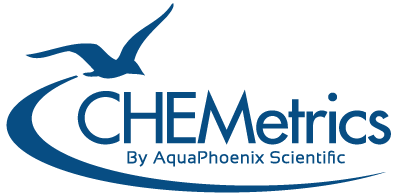Sulfite (free) Test Kits

What is Sulfite?
“Sulfites” include compounds containing the sulfite ion (SO32-), sulfur dioxide, bisulfites and metabisulfites. Because sulfite is a strong reducing agent, it is commonly used as an oxygen scavenger in low pressure boiler systems to inhibit corrosion. Sulfite reduces dissolved oxygen and is oxidized to sulfate in the process. It is most often added as a sodium or potassium derivative. Due to the low cost of sulfite compounds, they are the preferred oxygen scavengers for many operators. Sulfite may also be present in treated industrial wastewater but is not usually present in natural bodies of water since it is easily oxidized to sulfate.
Sulfite occurs naturally in some foods and is also frequently used as a preservative in certain foods and beverages. Its use is particularly prominent in the wine industry where it is added as an antioxidant, antimicrobial agent, and to stop fermentation at a set point. Sulfites have been identified as causative agents in certain allergic reactions suffered by asthmatics. Due to this the US Food and Drug Administration and Bureau of Alcohol, Tobacco, and Firearms have mandated that sulfites in foods and beverages be identified on the product label if they are at levels 10 ppm or higher.
Why Test for Sulfite in Water?
Sulfite levels in boiler water are measured to ensure application of correct dosage amounts and sufficient residual to prevent corrosion within the system. Frequent testing can keep costs low by preventing costly maintenance and wasted chemicals.
Sulfite is measured in the food and beverage industry to ensure production facilities operate within prescribed limits. The sulfite concentration in wine is measured at different points in the fermentation and/or packaging processes, to verify that levels are sufficient to prevent spoilage and yet low enough to maintain the quality of the wine. Sulfite tests can prevent wasting time and money on product that is not meeting the necessary requirements to ship.
About Our Test Kits
CHEMetrics Sulfite test kits utilize Titrets® ampoules. Titrets ampoules use a reverse titration technique to measure analyte concentration levels (titrant volume inside the ampoule is fixed while the sample volume is varied). After snapping the ampoule tip, sample is drawn into the test ampoule in small doses until a color change signals the endpoint has been reached. The titration is stopped at the end point, and the liquid level in the ampoule corresponds to the concentration printed on a scale on the ampoule’s outer surface.
The titration employed with our sulfite water analysis test kits is the iodometric method. This chemistry, commonly referred to as the Ripper Method in the wine industry, is also employed with our Sulfite in White Wines test kit. Read more about each at the bottom of the page.
Note: CHEMetrics free sulfite kits can be used to measure thiosulfate. Multiply test results by 1.4 to convert from ppm sulfite (SO3) to ppm thiosulfate (S2O3). The sulfite kits cannot distinguish between thiosulfate and sulfite.
Click on a catalog number in the tables below for more information or to purchase a test kit.
Visual Kits
| Range | MDL | Method | Kit Catalog No. | Refill Catalog No. |
|---|---|---|---|---|
| 2-20 ppm as SO3 | 2.0 ppm | Iodometric | K-9602 | |
| 5-50 ppm as SO3 | 5.0 ppm | Iodometric | K-9605 | |
| 10-100 ppm as SO3 | 10 ppm | Iodometric | K-9610 | |
| 50-500 ppm as SO3 | 50 ppm | Iodometric | K-9650 | |
| 10-100 ppm as SO2 | 10 ppm | Ripper (Sulfite in Wine) | K-9610W |
Methods
References: ASTM D 1339-84, Sulfite Ion in Water, Test Method C. APHA Standard Methods, 23rd ed., Method 4500-SO32– B – 2000. USEPA Methods for Chemical Analysis of Water and Wastes, Method 377.1 (1983). CHEMetrics’ sulfite test kits employ the iodometric chemistry in which sulfite is titrated with iodide-iodate titrant in an acid solution using a starch indicator. Thiosulfate will titrate as sulfite. Sulfamic acid is added to the sample to prevent interference from nitrite. Results are expressed as ppm (mg/L) SO3.
References: ASTM D 1339-84, Sulfite Ion in Water, Test Method C. APHA Standard Methods, 23rd ed., Method 4500-SO32– B -2000. USEPA Methods for Chemical Analysis of Water and Wastes, Method 377.1 (1983).CHEMetrics’ sulfite test kit is based on the Ripper method, which the wine industry has used for years as a standard for rapid sulfite analysis. Sulfite is titrated with an iodide-iodate solution, using a starch end point indicator. Phosphoric acid is used to adjust the pH of the sample.Results are quantified using direct-reading titration cells. The test determines free sulfite as ppm (mg/L) SO2.Results for this test kit are acceptable for white wines (although they can have an error of up to 10 ppm). This test kit is not recommended for use with red wines or white wines containing ascorbic acid or tannin. These wines often give false high test results.

